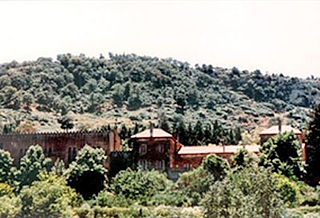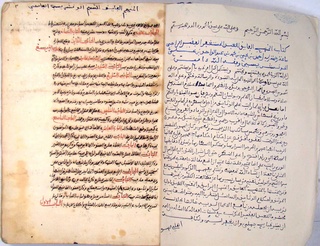Related Research Articles

Wahhabism is a Sunni Islamic revivalist and fundamentalist movement associated with the reformist doctrines of the 18th-century Arabian Islamic scholar, theologian, preacher, and activist Muhammad ibn Abd al-Wahhab. He established the Muwahhidun movement in the region of Najd in central Arabia as well as South Western Arabia, a reform movement that emphasised purging of rituals related to the veneration of Muslim saints and pilgrimages to their tombs and shrines, which were widespread amongst the people of Najd. Ibn ʿAbd al-Wahhab and his followers were highly inspired by the influential thirteenth-century Hanbali scholar Ibn Taymiyyah who called for a return to the purity of the first three generations (Salaf) to rid Muslims of inauthentic outgrowths (bidʻah), and regarded his works as core scholarly references in theology. While being influenced by their Hanbali doctrines, the movement repudiated Taqlid to legal authorities, including oft-cited scholars such as Ibn Taymiyya and Ibn Qayyim.

Abū Zakariyyā Yaḥyā ibn Sharaf al-Nawawī (Arabic: أبو زكريا يحيى بن شرف النووي;, popularly known as al-Nawawī or Imam Nawawī, was a Sunni Shafi'ite jurist and hadith scholar. He authored numerous and lengthy works ranging from hadith, to theology, biography, and jurisprudence. Al-Nawawi never married.

Ibn Taymiyyah, birth name Taqī ad-Dīn ʾAḥmad ibn ʿAbd al-Ḥalīm ibn ʿAbd al-Salām al-Numayrī al-Ḥarrānī, was a Sunni Muslim ʿĀlim, muhaddith, judge, proto-Salafist theologian, and sometimes controversial thinker and political figure. He is known for his diplomatic involvement with the Ilkhanid ruler Ghazan Khan and for his involvement at the Battle of Marj al-Saffar which ended the Mongol invasions of the Levant. A member of the Hanbali school, Ibn Taymiyyah's iconoclastic views that condemned numerous folk practices associated with saint veneration and the visitation of tomb-shrines made him unpopular with many scholars and rulers of the time, and he was imprisoned several times.

The Armed Islamic Group was one of the two main Islamist insurgent groups that fought the Algerian government and army in the Algerian Civil War.

Ahmad ibn Hanbal al-Dhuhli, was a Muslim jurist, theologian, ascetic, hadith traditionist, and founder of the Hanbali school of Sunni jurisprudence — one of the four major orthodox legal schools of Sunni Islam.
Takfir or takfīr is an Arabic and Islamic term which denotes excommunication from Islam of one Muslim by another, i.e. accusing another Muslim to be an apostate. The word is found neither in the Quran nor in the ḥadīth literature; instead, kufr ("unbelief") and kāfir ("unbeliever") and other terms employing the same triliteral root k-f-r appear. "The word takfīr was introduced in the post-Quranic period and was first done by the Khawarij," according to J. E. Campo. The act which precipitates takfīr is termed mukaffir. A Muslim who declares another Muslim to be an unbeliever or apostate is a takfīri ("excommunicational").

Abū al-Ḥusayn ‘Asākir ad-Dīn Muslim ibn al-Ḥajjāj ibn Muslim ibn Ward ibn Kawshādh al-Qushayrī an-Naysābūrī or Muslim Nayshāpūrī, commonly known as Imam Muslim, was an Islamic scholar from the city of Nishapur, particularly known as a muhaddith. His hadith collection, known as Sahih Muslim, is one of the six major hadith collections in Sunni Islam and is regarded as one of the two most authentic (sahih) collections, alongside Sahih al-Bukhari.

The Idrisid dynasty or Idrisids were an Arab Muslim dynasty from 788 to 974, ruling most of present-day Morocco and parts of present-day western Algeria. Named after the founder, Idris I, the Idrisids were an Alid and Hasanid dynasty, descended from Muhammad. The Idrisids are traditionally considered to be the founders of the first Moroccan Muslim state, setting the stage for subsequent dynasties and states centered in this region. Their reign played an important role in the early Islamization of Morocco and also presided over an increase in Arab immigration and Arabization in major urban centers.
ʾAḥmad ibn Yaḥyā ibn Jābir al-Balādhurī was a 9th-century Muslim historian. One of the eminent Middle Eastern historians of his age, he spent most of his life in Baghdad and enjoyed great influence at the court of the caliph al-Mutawakkil. He travelled in Syria and Iraq, compiling information for his major works.
Yahya Michot is a Belgian Muslim who is a professor of Islamic studies.

Shaykh al-Islām was used in the classical era as an honorific title for outstanding scholars of the Islamic sciences. It first emerged in Khurasan towards the end of the 4th Islamic century. In the central and western lands of Islam, it was an informal title given to jurists whose fatwas were particularly influential, while in the east it came to be conferred by rulers to ulama who played various official roles but were not generally muftis. Sometimes, as in the case of Ibn Taymiyyah, the use of the title was subject to controversy. In the Ottoman Empire, starting from the early modern era, the title came to designate the chief mufti, who oversaw a hierarchy of state-appointed ulama. The Ottoman Sheikh al-Islam performed a number of functions, including advising the sultan on religious matters, legitimizing government policies, and appointing judges.

Muḥammad al-Shawkānī (1759–1834) was a prominent Yemeni Sunni Islamic scholar, jurist, theologian and reformer. Shawkani was one of the most influential proponents of Athari theology and is revered as one of their canonical scholars by Salafi Muslims. His teachings played a major role in the emergence of the Salafi movement. Influenced by the teachings of the medieval Hanbali polemicist Ibn Taymiyya, Al-Shawkani became noteworthy for his staunch stances against the practice of Taqlid, calls for direct interpretation of Scriptures, opposition to Kalam as well as for his robust opposition to various folk practices which he condemned as shirk (idolatry).
Jamāl al-Dīn Abū al-Ḥajjāj Yūsuf ibn al-Zakī ʻAbd al-Raḥmān ibn Yūsuf ibn ʻAbd al-Malik ibn Yūsuf al-Kalbī al-Quḍā’ī al-Mizzī,, also called Al-Ḥāfiẓ Abī al-Ḥajjāj, was a Syrian muhaddith and the foremost `Ilm al-rijāl Islamic scholar.

God in Islam is seen as the eternal creator and sustainer of the universe, who will eventually resurrect all humans. In Islam, God is conceived as a perfect, singular, immortal, omnipotent, and omniscient god, completely infinite in all of his attributes. Islam further emphasizes that God is most-merciful.
Abū Muṣʿab Aḥmad ibn Abī Bakr al-Qāsim ibn al-Ḥārith al-Zuhri, 767–856 CE / 150–242 AH, was a Muslim scholar and judge who was a student of Malik ibn Anas.

Wael B. Hallaq is the Avalon Foundation Professor in the Humanities at Columbia University, where he has been teaching ethics, law, and political thought since 2009. He is considered a leading scholar in the field of Islamic legal studies, and has been described as one of the world's leading authorities on Islamic law.

On the night of 26–27 March 1996, seven monks of the Trappist order from the Our Lady of the Atlas Abbey of Tibhirine near Médéa, Algeria, were kidnapped during the Algerian Civil War. They were held for two months, and found dead in late May 1996. The circumstances of their kidnapping and death remain controversial; the Armed Islamic Group claimed responsibility for both, but in 2009, retired General François Buchwalter reported that the monks were killed by the Algerian army.

Ahmad ibn Yahya al-Wansharisi was a Maghrebi Berber Muslim theologian and jurist of the Maliki school around the time of the fall of Granada. He was one of the leading authorities on the issues of Iberian Muslims living under Christian rule.
'Ala' al-Din al-Bukhari, was a Hanafi jurist (faqih), Maturidi theologian, commentator of the Qur'an (mufassir), and a mystic (Sufi). Sa'id Foudah suggest that he followed the Naqshbandi path.

The Sulaymanid dynasty was an Arab Muslim dynasty in present-day western Algeria, ruling from 814 to 922. The dynasty is named after the founder, Sulyaman I, who was the brother of Idris I, the founder of the Idrisid dynasty based in Fez. Both Sulayman and Idris, as great grandchildren of Hasan ibn Ali, were sharifs descended from Muhammad.
References
- 1 2 Michot, Yahyah (2010). "Ibn Taymiyya's "New Mardin Fatwa". Is genetically modified Islam (GMI) carcinogenic?" (PDF). Hartford Seminary- the Muslim World (1). Retrieved 6 August 2016.
- 1 2 Hassan, Hassan (9 April 2012). "A religious basis for violence misreads original principles". The National. The National. Retrieved 6 August 2016.
- ↑ Oxford University Gazette, 23 September 1999